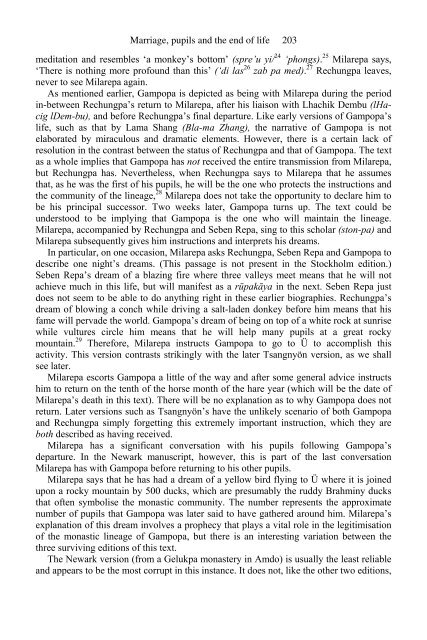The Biographies of Rechungpa: The Evolution of a Tibetan ...
The Biographies of Rechungpa: The Evolution of a Tibetan ...
The Biographies of Rechungpa: The Evolution of a Tibetan ...
You also want an ePaper? Increase the reach of your titles
YUMPU automatically turns print PDFs into web optimized ePapers that Google loves.
Marriage, pupils and the end <strong>of</strong> life 203<br />
meditation and resembles ‘a monkey’s bottom’ (spre’u yi/ 24 ‘phongs). 25 Milarepa says,<br />
‘<strong>The</strong>re is nothing more pr<strong>of</strong>ound than this’ (‘di las 26 zab pa med). 27 <strong>Rechungpa</strong> leaves,<br />
never to see Milarepa again.<br />
As mentioned earlier, Gampopa is depicted as being with Milarepa during the period<br />
in-between <strong>Rechungpa</strong>’s return to Milarepa, after his liaison with Lhachik Dembu (lHacig<br />
lDem-bu), and before <strong>Rechungpa</strong>’s final departure. Like early versions <strong>of</strong> Gampopa’s<br />
life, such as that by Lama Shang (Bla-ma Zhang), the narrative <strong>of</strong> Gampopa is not<br />
elaborated by miraculous and dramatic elements. However, there is a certain lack <strong>of</strong><br />
resolution in the contrast between the status <strong>of</strong> <strong>Rechungpa</strong> and that <strong>of</strong> Gampopa. <strong>The</strong> text<br />
as a whole implies that Gampopa has not received the entire transmission from Milarepa,<br />
but <strong>Rechungpa</strong> has. Nevertheless, when <strong>Rechungpa</strong> says to Milarepa that he assumes<br />
that, as he was the first <strong>of</strong> his pupils, he will be the one who protects the instructions and<br />
the community <strong>of</strong> the lineage, 28 Milarepa does not take the opportunity to declare him to<br />
be his principal successor. Two weeks later, Gampopa turns up. <strong>The</strong> text could be<br />
understood to be implying that Gampopa is the one who will maintain the lineage.<br />
Milarepa, accompanied by <strong>Rechungpa</strong> and Seben Repa, sing to this scholar (ston-pa) and<br />
Milarepa subsequently gives him instructions and interprets his dreams.<br />
In particular, on one occasion, Milarepa asks <strong>Rechungpa</strong>, Seben Repa and Gampopa to<br />
describe one night’s dreams. (This passage is not present in the Stockholm edition.)<br />
Seben Repa’s dream <strong>of</strong> a blazing fire where three valleys meet means that he will not<br />
achieve much in this life, but will manifest as a rūpakāya in the next. Seben Repa just<br />
does not seem to be able to do anything right in these earlier biographies. <strong>Rechungpa</strong>’s<br />
dream <strong>of</strong> blowing a conch while driving a salt-laden donkey before him means that his<br />
fame will pervade the world. Gampopa’s dream <strong>of</strong> being on top <strong>of</strong> a white rock at sunrise<br />
while vultures circle him means that he will help many pupils at a great rocky<br />
mountain. 29 <strong>The</strong>refore, Milarepa instructs Gampopa to go to Ü to accomplish this<br />
activity. This version contrasts strikingly with the later Tsangnyön version, as we shall<br />
see later.<br />
Milarepa escorts Gampopa a little <strong>of</strong> the way and after some general advice instructs<br />
him to return on the tenth <strong>of</strong> the horse month <strong>of</strong> the hare year (which will be the date <strong>of</strong><br />
Milarepa’s death in this text). <strong>The</strong>re will be no explanation as to why Gampopa does not<br />
return. Later versions such as Tsangnyön’s have the unlikely scenario <strong>of</strong> both Gampopa<br />
and <strong>Rechungpa</strong> simply forgetting this extremely important instruction, which they are<br />
both described as having received.<br />
Milarepa has a significant conversation with his pupils following Gampopa’s<br />
departure. In the Newark manuscript, however, this is part <strong>of</strong> the last conversation<br />
Milarepa has with Gampopa before returning to his other pupils.<br />
Milarepa says that he has had a dream <strong>of</strong> a yellow bird flying to Ü where it is joined<br />
upon a rocky mountain by 500 ducks, which are presumably the ruddy Brahminy ducks<br />
that <strong>of</strong>ten symbolise the monastic community. <strong>The</strong> number represents the approximate<br />
number <strong>of</strong> pupils that Gampopa was later said to have gathered around him. Milarepa’s<br />
explanation <strong>of</strong> this dream involves a prophecy that plays a vital role in the legitimisation<br />
<strong>of</strong> the monastic lineage <strong>of</strong> Gampopa, but there is an interesting variation between the<br />
three surviving editions <strong>of</strong> this text.<br />
<strong>The</strong> Newark version (from a Gelukpa monastery in Amdo) is usually the least reliable<br />
and appears to be the most corrupt in this instance. It does not, like the other two editions,











